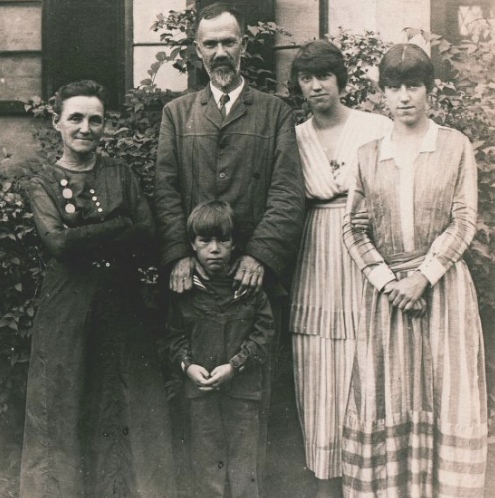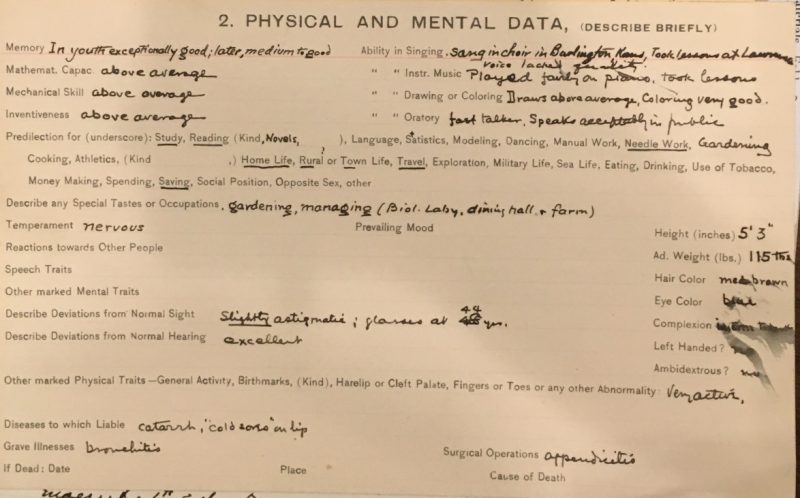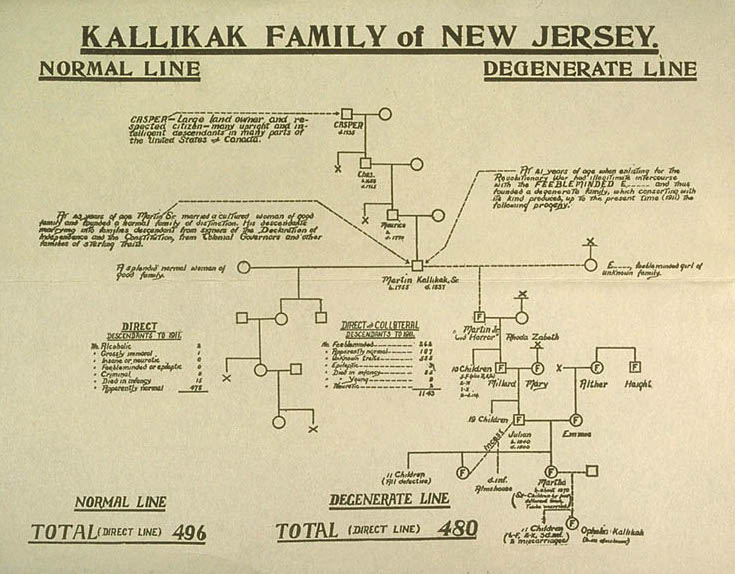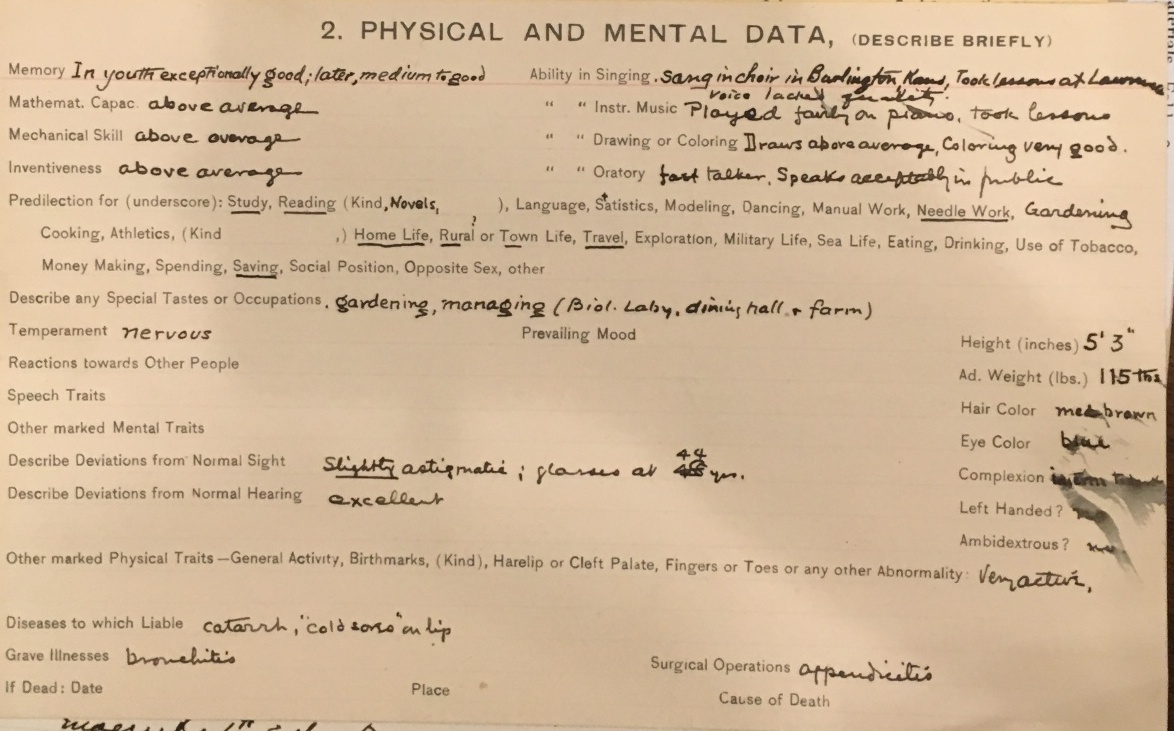By Jenna Tonn
Serena Joy from The Handmaid’s Tale represents a special brand of conservative feminism, one whose traditionalist social policies contribute to the making of the the patriarchal Gilead and to the negation of her own political power. Women similar to Serena Joy can be found throughout history. There were the white women who happily organized on behalf of the KKK and white supremacy in the 1920s and 1930s, and there are the 53% of white women who voted for Trump in 2016. In these cases, both real and fictional, middle class white women ignore gender solidarity in favor of promoting differences in class, race, religion, ethnicity, and sexuality, differences that serve to consolidate the power of the patriarchy. Gertrude Davenport, a pioneering woman in science in the early 20th century, shares these characteristics.
I am interested in recovering Gertrude Davenport’s life and work, often relegated to a footnote in histories about her husband, the famous eugenicist Charles Davenport. The results of this recovery are unsettling. She was considered by some to be a feminist as a notable woman in science, but like many progressive white women at the time, she also actively promoted a eugenic agenda that perpetuated the disenfranchisement of immigrants, working class women, and individuals with disabilities. Understanding Davenport as a significant but flawed scientist reveals that the women we look for in the past in order to write a more equitable history of science in the present can, to our dismay, turn out to be complicit in promoting oppressive power structures.

Figure 1. Gertrude Davenport (left) with Charles Davenport and others, 1916. Source: American Philosophical Society.
Davenport’s life fits with the classic career trajectories of early 20th century women in science. She was a highly-educated zoologist, who, after graduating from the University of Kansas in 1889, pursued an advanced degree at Radcliffe College in 1892. There, she met and married her instructor, Charles Davenport, and took on the roles of wife and mother, as well as primary intellectual collaborator and the co-manager of Charles’s professional life. Their work together proved foundational to the U.S. eugenics movement between 1900 and 1930, and their coupled enthusiasm for studying human heredity had far-reaching social and cultural consequences.
In various ways, eugenics practitioners, a loose coalition of scientists, policy-makers, and Progressive Era reformers, encouraged “fit” individuals to reproduce and supported social, medical, and legal policies to prevent reproduction by “unfit” individuals. During this period, biological notions of hereditarian worth reflected the values of white, middle and upper-middle class Americans like the Davenports. As result, eugenicist ideologies underwrote coercive sterilization measures, restrictive immigration quotas, and the institutionalization of transgressive men, women, and children.
The Davenports’ working relationship formed the basis of a series of co-authored publications, from a well-received introductory zoology textbook to a series of high profile studies of human heredity. They published articles on the inheritance of eye-color, hair color and texture, and skin pigment, all of which suggested in various ways that human physical traits were determined by discrete Mendelian factors (or genes). Each ended with a statement on the most pressing social question at hand: the “practical application” of how marriage influences the passage of these traits to the next generation. It is perhaps no surprise that the Davenports, using their own methods, rated themselves hereditarily above average.

Figure 2. Gertrude Davenport, Eugenics Record Card, undated. Source: American Philosophical Society.
One might go so far as to argue that the Davenports’ marriage was central to the eugenics movement. The Davenports lived a personally fulfilling and scientifically compatible partnership, and their research on human heredity imagined a world where their marriage provided a template for all others. As Charles Davenport wrote in “How a Eugenicist Looks at the Matter of Marriage” in 1928 for a magazine called Good Health, marriage boiled down to genetic transparency, pro-natalist policies, and “above all, the inculcation of self-control and mutual regard as the best means of securing a happy marriage.” Seen from this perspective and from the work that Gertrude published with and without her husband, she was central to his career and the promotion of their shared vision of a biologically pure future.
While historians have tried to understand how Charles’s organizational abilities motivated the U.S. eugenics movement, Gertrude Davenport’s role has been largely overlooked. E. Carleton MacDowell suggests in the biography “Charles Benedict Davenport, 1866-1944: A Study of Conflicting Influences” that marriage gave Charles needed structure: “She, and she alone, was his confidante and chief counselor.” MacDowell acknowledges in an unpublished account that Gertrude was “in her own right, zoologist, teacher, author, farmer, and for many years active in the management of the Biological Laboratory at Cold Spring Harbor.” More recently, Mark Largent has suggested in his book Breeding Contempt: The History of Coerced Sterilization in the United States that Gertrude’s interest in eugenics might have predated and influenced her husband’s.
In 1907, Gertrude Davenport, leveraging her association with the Cold Spring Harbor Laboratory, publicized a provocative European family study to American audiences. In “Hereditary Crime,” she reported on Swiss research into the Zero family in Zand, an anonymized European clan in a remote village whose family tree had good and bad branches. While the good branches were healthy and moral, the bad branches exhibited criminality, drunkenness, insanity, and a vagabond nature. No amount of environmental change could remediate the deficient Zeros’ path toward destruction, caused in part by an ill-advised marriage to a foreign woman.
As Nicole Hahn Rafter has noted in her book White Trash: The Eugenic Family Studies, 1877-1919, Davenport’s summary of this study amplified the message of “the habitual criminal as a special breed of human, analogous to the racehorse as a special breed of horse.” Davenport’s piece introduced what became a hallmark in eugenically-motivated family studies in the US and abroad: tracing degenerate germ plasm to transgressive women.

Figure 3. Degenerate line of the Kallikak Family caused by "feebleminded girl of unknown family." Source: Eugenics Archive and APS.
In her popular writing, Davenport encouraged U.S. readers to use hereditary data to interpret the social and political world around them. In a 1912 article in The Independent titled “The Eugenics Movement,” she calculated that having approximately five-percent of the population “incompetent thru [sic] such bad heredity as imbecility, criminality and disease” cost the American taxpayers around $100 million per year. Later in 1914, in another article, “Society and the FeebleMinded,” Davenport argued for transparent self-reporting of hidden “defects” in individuals and their families. Keeping degeneracy a secret is “highly anti-eugenical and brings its punishment not only on the family but on society,” she wrote. The world, in Davenport’s eyes, was full of people hiding their contaminated genetic factors.
Journalists including Florence Finch Kelly looked up to Davenport as emblematic of a successful woman in science during the early 20th century. In 1910, Kelly wrote to Davenport to inquire about her scientific partnership with her husband. While Kelly had been given an assignment to cover Charles Davenport’s high-profile center for studying heredity, the Station for Experimental Evolution, she was more interested in using the opportunity to showcase Gertrude’s work. Kelly’s goal was a feminist one. Kelly argued it was “a sort of duty to our sex” to show that women could be wives, mothers, and highly successful professionals. In the resulting New York Times article, Kelly portrays Davenport as an active collaborator in the scientific work of the station — the brilliant Marie Curie to Charles’s Pierre.
What are we to make of the brilliant Curie-like Gertrude Davenport? She was one of only a handful of women active at elite levels in biology during this period. She continued to conduct original research, write for scientific and popular audiences, manage a research station, and teach new generations of scientists and fieldworkers about eugenics. But at the same time, her enthusiasm for simplifying human heredity made her complicit in promoting ideas that disproportionately affected women. She promoted a scientific perspective, popular at the time among many white feminists, that divided the world into good and bad germ plasm and viewed women, particularly poor, immigrant women, as the vectors of degenerate hereditarian material that could contaminate previously pure family lines. Recovering Davenport’s work contributes to the larger project of identifying women in science as historical actors in their own right, and in acknowledging that, we must recognize that they are not all the heroes we wish them to be.
*All cited correspondence comes from the American Philosophical Society archives
Further reading
Alexandra Minna Stern, Eugenic Nation: Faults and Frontiers of Better Breeding in Modern America (University of California Press, 2015).
Dorothy Roberts, Killing the Black Body: Race, Reproduction, and the Meaning of Liberty (Vintage, 1999).
Mark A. Largent, Breeding Contempt: The History of Coerced Sterilization in the United States (Rutgers University Press, 2011).
Troy Duster, Backdoor to Eugenics, 2nd ed. (Routlege, 2003).
Wendy Kline, Buildling a Better Race: Gender, Sexuality, and Eugenics from the Turn of the Century to the Baby Boom (University of California Press, 2005).
Lady Science is an independent magazine that focuses on the history of women and gender in science, technology, and medicine and provides an accessible and inclusive platform for writing about women on the web. For more articles, information on pitching, and to subscribe to our newsletter, visit ladyscience.com.
